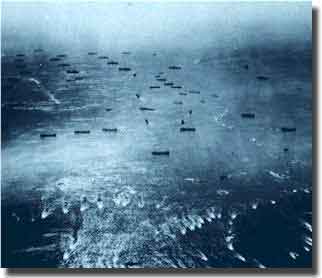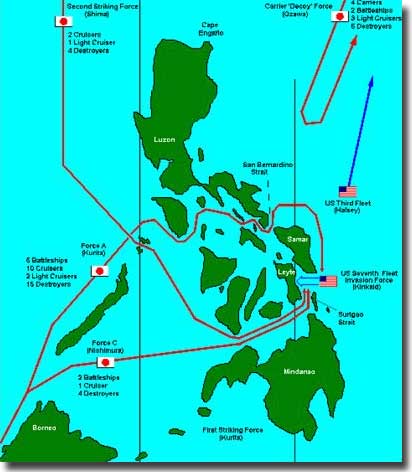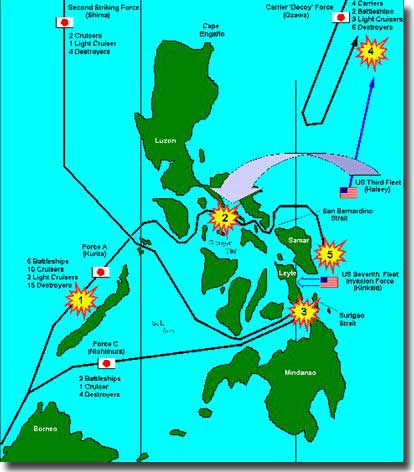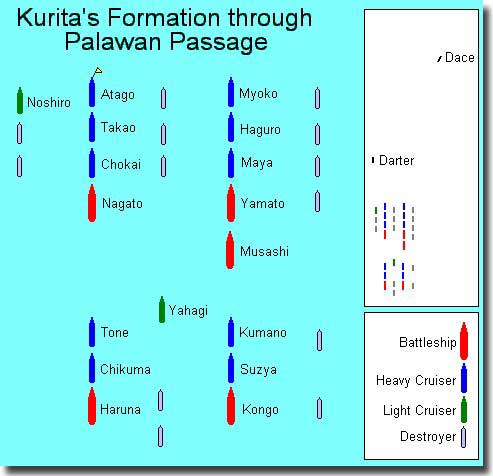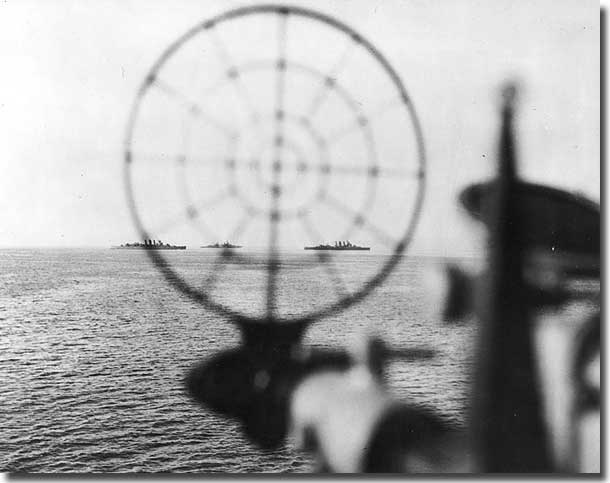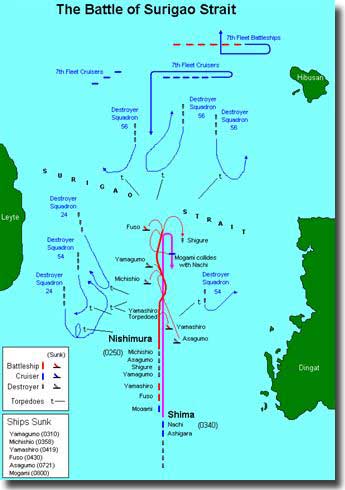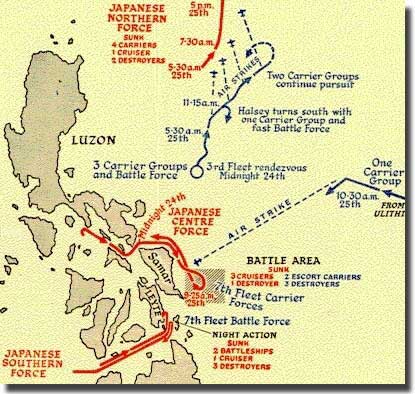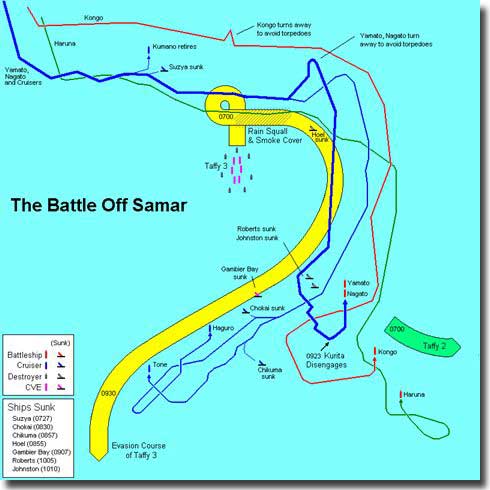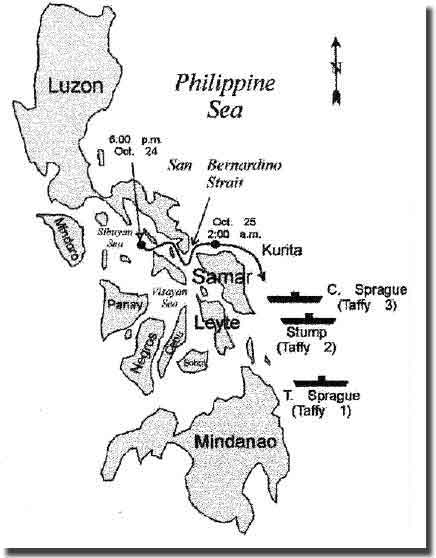|
The Battle of Leyte Gulf. 23 - 26 October 1944
(See more pictures here and here)
War in the Pacific. May of 1942 saw the Battle of the Coral Sea, probably a draw, but a strategic victory for the Allies, stopping the Japanese from a seawards invasion of Port Moresby, forcing them to fight overland in New Guinea. Midway came the next month in June, this indeed was a US victory. On May 30/June 1, the Japanese attacked Sydney Harbour with 3 midget submarines, 2 were sunk, 1 escaped, never to be seen again. The only real damage, the sinking of the old accommodation ferry HMAS Kuttabul, with the loss of 23 lives. The Japanese invaded Tulagi and Guadalcanal in the Solomons in May, resulting in Admiral Ernest King USN in mounting Watch Tower, a US landing of Marines to wrest these strategically placed islands back from the Japanese. The Battle of Savo Island occurred on the night of the 9th. of August 1942, with the loss of 4 heavy Allied cruisers and 1,000 sailors. Now, over August/November 1942 the future of the Pacific War was decided in and around the Solomon Islands, with the Naval Battles of the Solomons, these proved disastrous for the Japanese Navy, depriving their Carrier force of much of its trained aircrews, which could not be replaced. A string of victories in New Guinea followed, the capture of Hollandia in Dutch New Guinea, and the Admiralty Islands squatting close to the equator, set up American forward bases to act as a springboard for the return to the Philippines. Roosevelt backs MacArthur against Nimitz to go for the Philippines.
Without any hesitation MacArthur responded with :
Nimitz now strongly argued to by pass the Philippines and attack Formosa, once acquired, this base would allow the Japanese mainland to be bombed, and the supply line between the East Indies and Japan harried, to quench the flow of oil and essential supplies needed to prosecute their war. Whilst Roosevelt could appreciate the cogency of this advice, he listened to MacArthur who reminded him of the US promise at the time of the loss of the Philippines, to liberate this territory from the Japanese yoke, to break this promise with an election looming in the US in November, might well reflect in the President being turned against by the American voters. The political argument prevailed, and the date to invade the Philippines was set for October 1944. Battle of the Philippine Sea. US Task Force 58, the Fast Carrier Force, destroyed about 200 Japanese aircraft in one afternoon. Three Japanese carriers were sunk, and over two days, nearly 500 land and sea based aircraft were shot down. This decisive defeat of Japanese air power at sea would subsequently benefit the US Naval Forces that were to converge upon the Philippines at Leyte in October of 1944. United States Submarines Success. The need for Japan to hang on to the Philippines. The Japanese Plan.
The fleets Strait south of Leyte. The central force commanded by Vice Admiral Kurita, with 5 battleships, 10 heavy cruisers, 2 light cruisers and 15 destroyers would push through San Bernadino Strait, sail down the coast of Samar, and attack the US invasion force from the North East.
Strength of the Japanese and US Naval Forces at the Battle of Leyte Gulf. (Table 1)
The Battle of Leyte Gulf.
Chart for the five battles US Third and Seventh Fleets. The Third Fleet under the command of Bull Halsey who in turn reported to Admiral Nimitz, in Command of Central Pacific, was supposed to provide cover for the Seventh Fleet. Suprisingly no overall Naval Commander was appointed for this campaign, as Kinkaid reported to MacArthur's Southwest Pacific Command, this split of the Naval Command led to much confusion in the forthcoming engagements, and very nearly led to a total strategic disaster for the Allied forces. The drawing showing the Naval Command structure to go inhere please. Terry, could the first chart go in here please, plus the chart of Kurita's force? 1. Two US Submarines attack Japanese forces in the Palawan Passage.
Kuritas Formation in the Palawan Passage Composition of Admiral William Halsey's Third Fleet. American Third Fleet. Admiral William Halsey in command in the battleship, New Jersey. This huge fleet in the main was made up by Task Force 38, under the command of Vice Admiral Marc Mitscher in the Fleet Carrier Lexington. TF38, was known as the Fast Carrier Force, made up by 8 Fleet Carriers, 9 Light Carriers, 8 Battleships, 6 Heavy Cruisers, 9 Light Cruisers, and 59 Destroyers. In turn, it broke down into 4 distinct Task Groups:- Task Group One, or TG 38.1.
Task Group Two or TG 38.2.
Task Group Three or TG 38.3.
Task Group Four or TG 38.4.
Halsey decides to sent off two groups to Ulithi to restore and rearm. When Darter sent off her enemy report to Halsey that they were in contact with Admiral Kurita's Central Force, the Third Fleet Commander ordered Davison to about turn and bring his group back to rejoin him, but he allowed McCain's Task Group to continue on to Ulithi. TG 38.1 with 3 Fleet Carriers and 2 Light Carriers was by far the strongest of all the 4 Carrier Groups. Halsey's decision to detach the two groups, but recall one, robbed the Third Fleet of almost 40% of its air power. Kurita takes his Central Force Eastwards into the Palawan Passage. On the 24th. of October, carrier aircraft from the Third Fleet found this large Japanese force, Bogan's Task Group was the closest to the enemy, his group also was the smallest, with one Fleet Carrier Intrepid and two Light Carriers. The most northern of the Carrier groups was Sherman's TG 38.3, it was now heavily attacked by Japanese bombers land based on Luzon, three separate raids, each of which contained 50/60 incoming bombers. Although both the US carriers fighters and AA fire put up a valiant defence, one enemy dive bomber broke through, hitting the Light Carrier Princeton with a bomb, causing fires and a subsequent explosion in her torpedo stowage, and resulting in her abandonment. The cruiser Birmingham alongside rendering assistance was caught up in the explosion, and suffered horrendous crew casualities. Six separate waves of US carrier aircraft pounded Kurita's ships inflicting major damage on his force. Musashi, a sister ship to the mighty Yamato was pounded by successive waves of US carrier borne aircraft, a number of torpedo hits slowed her down , she dropped astern to become even more vulnerable, until finally at 1935 ( 7.35 PM ) she capsized and sank, reportedly hit by 10 bombs and up to 19 torpedoes. Kurita could ill afford to lose one of his premier battleships, his pride already severely dented by having to swim for it after Darter sank his flagship under him. The heavy cruiser Myoko was forced to retire having taken a torpedo hit, several other of this group were hit by bombs by managed to stay and keep up with the force. Although Kurita when attacked had turned away, he now resumed a course for San Bernadino Strait, still with a formidable fleet of 4 Battleships, 6 Heavy Cruisers, 2 Light Cruisers and about 12 Destroyers. His Commander- in-Chief of the Combined Fleet, Admiral Toyoda sent Kurita a signal:-
Something even more was going to be needed for Admiral Kurita and his ships! But what about the Southern Japanese force? American aircraft had sighted both these groups on the morning of the 24th. of October, it was believed that the Seventh Fleet had sufficient muscle to deal with them in due course. Halsey makes momentous decision to go after the Japanese Northern Force. The Japanese pilots were so inept, they failed to return to their mother ships, and landed on airfields in Luzon. Now at last, at 1540 ( 3.40 PM ) on the 24th. of October, Halsey knew where Ozawa's battleships were located, an hour later, one of his search aircraft found the Japanese carriers. Halsey decides. He now decided to take all Three Task Groups away from their blocking and support role, outside San Bernadino Strait, he ordered all his carriers plus their supporting 6 fast battleships to steam northwards to intercept Ozawa's force, and in daylight hours of the 25th. of October, and annihilate them all. Halsey took no steps at all to protect the Seventh Fleet from the onrushing Japanese Central Force steaming for the exit at San Bernandino Strait. Vice Admiral Kinkaid in Command of the Seventh Fleet totally uninformed of Halsey's move. At 2022 ( 8.22 PM ) on the 24th. of October, Kinkaid had picked up a signal from Halsey to his Task Group Commanders indicating that he, as commander of the Third Fleet was going North with the three carrier Groups to take on the enemy Northern force. An earlier radio intercept by the Seventh Fleet had outlined a plan from Halsey to form Task Group 34, a powerful group to include the Third Fleet 6 fast battleships to be commanded by Vice Admiral Willis Lee. It was reasonable for Kinkaid and his staff to presume that this "Task Force 34 will be formed "signal, meant they would become the guardians of the San Bernandino Strait gate, they also assumed that the Three Groups mentioned by Halsey referred to the Three Carrier Groups. Not in Kinkaid's wildest dreams did he ever consider the exit from San Bernandino Strait would be left totally unguarded, with not even a warning picket destroyer sitting on watch. So, Vice Admiral Kinkaid went blissfully on planning to meet the envisaged threat from the Japanese Southern force expected in Suriago Strait. The Seventh Fleet. The Admiral used as his flagship, the amphibious command ship Wasatch. All up, the Seventh Fleet numbered some 738 ships, many of whom were amphibious warfare vessels, these divided into 2 groups - the Northern Attack Force, TF 78, commanded by Rear Admiral Daniel Barbey, and the Southern Attack Force, TF 79, under Vice Admiral T.S. Wilkinson. The 7th. Fleet Bombardment and Fire Support Group.
HMA Ships, Shropshire and Australia taken from USS Phoenix at Leyte in 1944. Escort Carrier Group TG 77.4 Rear Admiral Thomas Sprague in the Escort Carrier Sangamon.
Task Unit 77.4.3 Taffy Three.
The Battle of Suriago Strait. Jesse Oldendorf had been ordered by Kinkaid to put his force plus 39 PT Boats in place, to prevent the Japanese ships from moving through Suriago Strait whence they could attack the landings on the beaches at Leyte. These PT Boats were spread out covering a large area, 15 in the north, 15 in the centre and the remaining 9 cruising south of the Strait.
Chart of Battle of Suriago Strait The destroyers were closest to the Strait exit, with the 6 old Battleships, West Virginia, Tennessee, California, Pennsylvania, Mississippi, and Maryland, behind the Destroyer screen, but able to fire over the top of them. On the right flank were the Cruisers, HMAS Shropshire, Phoenix, and Boise with Rear Admiral Berkley commanding, on the left flank, the cruiser Louisville with the flag of Rear Admiral Oldendorf, plus the cruisers, Minneapolis, Portland, Denver, and Columbia. In addition, to the east of Leyte were a number of Destroyer Squadrons on patrol, Desron 54 with 5 DD's, Desron 24 with 6 DD's, including HMAS Arunta, Des Div Xray with 5 DD's, Desron 56, 9 DD's, plus a final 3 Destroyers. It was anticipated that the outlying PT Boats would be the first units to sight the approaching Japanese force, and would raise the alarm. Nishimura's Southern Force had been sighted by carrier aircraft and attacked, some minor damage had been inflicted on the Battleship Fuso, and an escorting Destroyer, but not sufficient to prevent them from maintaining their place in the line. The Japanese line of command was not clear cut, although overall command was vested in Admiral S. Toyodo based ashore, Nashimura of the Southern Force C reported to Vice Admiral Kurita of Southern Command, and Shima commanding the 2nd. Strike force was responsible to Vice Admiral of the South West Command of the 5th. Fleet. He was in fact senior to Nashimura, who had the Battleships in his charge, whilst Shima had to be content with the Cruiser force. There appeared to be no coordination between the two ship groups as they proceeded toward Surigao Strait. The Japanese plan had Nishimura arriving off the invasion beaches at 0500 ( 5 AM ) on the 25th. of October, to destroy MacArthur's landings, and Shuma was scheduled to arrive an hour later with his Cruisers to finish the job. The two groups had not worked together before, and already Shuma was two hours behind Nashimura's force, it did not look good for them. At about 2215 ( 10.15 PM ) PT Boats 130, 131, and 152 loosed their torpedoes at the Japanese fleet, without any tangible result. PT 152 was hit by a shell from a Japanese Destroyer, putting her radio out of action, and delaying the relay of an enemy report to Oldendorf. The US Battle fleet stood off Suriago Strait waiting to execute their commanding Admiral's plan, to put into effect of crossing the "T" used by Lord Nelson to defeat the enemy ships as they sailed in line ahead to be cut off, and then be destroyed by our broadsides, and in fact limit the nunber of guns the enemy could bring to bear on the Allied ships. Ships on the right flank were steaming at only 10 knots, the PT Boats were still in action, and the northern cruisers could see searchlights in action. At 0026. ( 0.26 AM ) Oldendorf finally learned that the Japanese ships were moving through Suriago Straits, but it took until 0215 ( 2.15 AM ) for the radar operators in Shropshire to detect Nashimura's Fleet at a range of 20 miles. The destroyers moved in at 30/35 knots, closing to only 4.3 miles before 47 torpedoes were on their way, hits were claimed. One on the Battleship Yamashiro, but she kept on steaming, two hits on the Battleship Fuso, stopped her, Yamagama was sunk, Mishishio stopped, and Asagumo had her bows blown off. It was now Shima's fleet's turn to face the wrath of the Allied destroyers, just after 0325 ( 3.25 AM ) Desron 24, which included HMAS Arunta launched a torpedo attack, and turned away. About 0338 ( 3.38 AM ) the Fuso blew up and broke in two, the main Battlefleet was about to let loose, and Arunta was warned "To get the hell, out of there" as she was in the line of fire and in extreme danger. At 0353 ( 3.53 AM ) all hell broke loose, the 6 US Battleships opened fire at 11 miles range, the 4 heavy Cruisers, the 4 light cruisers all joined in. Shropshire opened fire at a range of 9 miles, closing in to 7 miles. Hundreds of tons of both armour piercing and high explosive shells were poured into the Japanese Fleet. Shropshire alone fired 32 by 8 inch gun broadsides, over the space of just over 12 minutes and 40 seconds, playing her part in assisting to sink the Battleship Yamashiro. Mogami became a blazing wreck, but the Destroyer Shigura somehow survived. Nishimura had perished with his ship. Asukuma in Suma's formation had been torpedoed, and the Admiral decided to retire, but his Flagship collided with the blazing Mogami, and became badly damaged.
Leyte Gulf Track Chart at an important phase Battle off Cape Engano.
Battle off Samar. By the morning of the 25th. of October, 114,000 US troops had swarmed ashore on the Leyte beaches, and about 200,000 tons of supplies had been put ashore. Many of the empty transport ships had left the area, but many more with their full loads were milling around in the vicinity of the landing area. Taffy Three patrolled off the east coast of Samar in support of the troops that had landed at Leyte. At 0630 ( 6.30 AM ) Kurita and his Centre Force had burst through the San Bernandino Strait and were on a course of 170 degrees, heading for the landing beaches, but expecting to run into Halsey's Third Fleet. Lookouts in the Battleship Yamato's crows nest sighted mastheads, and thought they belonged to Carriers from the Third Fleet, never before had they seen mastheads of escort carriers, Kurita was unaware he had run into Rear Admiral Clifton Sprague's Taffy Three Group, 6 escort carriers, 3 destroyers, and 4 destroyer escorts. Indeed a rather puny match for his force.
Chart showing Kurita's force about to fall on Taffy Three in the Battle off Samar The Yamato's 18 inch main armament fired at the American ships, to splash dangerously close to the flagship Fanshaw Bay, his lookouts reported pagoda type masts, and Sprague knew he was in diabolical trouble, Japanese Battleships had his force under fire. Kinkaid sent off frantic messages to Halsey:-
Halsey responded including where his forces were at the time, to tell Kinkaid his assistance was not possible as his Fleet were too far north, as he had cleared off after Ozawa. In sheer desperation Kinkaid had sent off an uncoded message, ie in plain language.
By now Halsey was seriously alarmed, but now his boss Admiral Chester Nimitz chimed in with:-
Now when sending a coded message it was standard practice to preface and end a message with a nonsense phrase. Hence the beginning " Turkey Trots To Water" and " The World Wonders" ending. Normally the person decoding messages would delete both start and ending nonsense sentences, but apparently the signalman doing this job inadvertently left the last phrase "THE WORLD WONDERS." still in the signal given to Halsey. He reportedly became very angry, tearing off his cap, and throwing it on the deck of his bridge, but having taken the decision to chase after Ozawa, he and his Third Fleet were stranded, miles to the north, unable to offer any help to Kinkaid and his forces at Leyte. His 6 fast Battleships were despatched at speed to the south, but arrived a day after the Japanese had departed, too late to be of any use. By sending off his battleships, they could not chase, catch, and destroy Ozawa's battleships, they thus missed out at both ends. If Halsey had but stayed on guard off San Bernandino Straits, there seems little doubt he could have clobbered Kurita's battleships. Now! Follow this link http://www.odyssey.dircon.uk/Halsey_decision.htm to read all about HALSEY"S DECISION, from the US Navy Official History by Samuel Elliott Morison. With the help of smoke from his destroyers and a fortutious rain squall, Taffy Three hid briefly. Between the Jeep aircraft and torpedo attacks by the destroyers the Japanese were mauled, but at a high price. Hoel, Johnston, and Roberts, plus the Escort Carrier Gambier Bay were all sunk, and the remaining 4 destroyers were all badlky damaged. In turn Kurita's force lost, heavy cruisers Suzyo, Chikuma, and Chokai, and Kumano severely severely damaged. At 0923 ( 9.23 AM ) when Taffy Two showed up, Kurita unexpectedly turned to the north and disengaged. At last The Battle of Leyte Gulf was all over, the landing beaches safe, and General MacArthur had "INDEED RETURNED." Acknowledgement.
Mackenzie J. Gregory, Melbourne, Australia. 16th. of May 2003. (See more pictures here and here) (Source of the charts: http://www.battleship.org/html/Articles/History/Leyte0.htm) |

